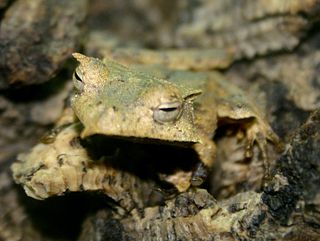Cyclostremellini is a minor tribe, a taxonomic grouping, of minute sea snails, marine gastropod mollusks or micromollusks, in the family Pyramidellidae, the pyrams and their allies.

Epomophorus is a genus of bat in the family Pteropodidae. They have a distribution throughout Africa.
Captain John Guy Dollman BA, FLS, known as Guy Dollman, was a British zoologist and taxonomist. Dollman's tree mouse and Dollman's vlei rat are named after him.

The Hemiphractidae are a family of frogs from South and Central America. Previously, this group had been classified as a subfamily (Hemiphractinae) under family Hylidae. More recent research classifies these genera into their own family, or sometimes into three separate families: Amphignathodontidae, Cryptobatrachidae, and Hemiphractidae (Hemiphractus). An active question still exists as to which of these groupings is more accurate.

The redbelly tilapia is a species of fish in the cichlid family. It is found widely in Africa and the Middle East, but has also been introduced outside its native range. It is an important food fish and sometimes seen in the aquarium trade. Its natural habitats are marginal vegetation and seasonal floodplain streams, lakes, and ponds. It was formerly included in the genus Tilapia as Tilapia zillii.
The Brown numbfish, also known as brown electric ray, is a species of numbfish in the family Narcinidae. It is found in Indo-West Pacific countries such as Pakistan off coast, India, Sri Lanka, to the Gulf of Thailand. They mainly live in continental waters, both inshore and offshore. The maximum length is about 22 cm (8.7 in).
Hylaeus sedens is a bee species endemic to Asia.
Pseudoanthidium orientale is a species of bee in the genus Pseudoanthidium, of the family Megachilidae.
Lipotriches fervida is a species of bees in the genus Lipotriches, of the family Halictidae.
Lipotriches pulchriventris is a species of bees in the genus Lipotriches, of the family Halictidae. It is widespread in Southeast Asia and variable in appearance, and has been given numerous names since its original description.
Lipotriches edirisinghei is a species of bee in the genus Lipotriches, of the family Halictidae.
Ceylalictus cereus is a species of bees in the genus Ceylalictus, of the family Halictidae.
Ceylalictus taprobanae is a species of bee in the genus Ceylalictus, of the family Halictidae.
Lasioglossum serenum, also known as the Lasioglossum (Nesohalictus) serenum, is a species of bee in the genus Lasioglossum, of the family Halictidae.
Lasioglossum alphenum, also known as the Lasioglossum (Sudila) alphenum by Sakagami et al. (1996), is a species of bees in the genus Lasioglossum, of the family Halictidae.
Anthidiellum krombeini is a species of leaf-cutting bee in the genus Anthidiellum, of the family Megachilidae.
Coelioxys formosicola is a species of leaf-cutting bee in the genus Coelioxys, of the family Megachilidae.
Thyreus insignis, is a species of bee belonging to the family Apidae subfamily Apinae.
Technomyrmex horni is a species of Dolichoderine ant which is a widespread species that can be found in many Indo-Australian, Oriental, and Palaearctic regions.




